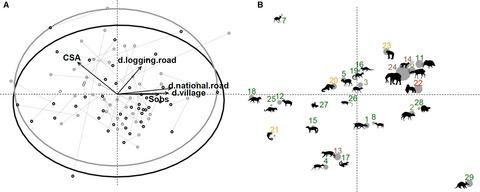当前位置:
X-MOL 学术
›
Remote Sens. Ecol. Conserv.
›
论文详情
Our official English website, www.x-mol.net, welcomes your feedback! (Note: you will need to create a separate account there.)
Wildlife trail or systematic? Camera trap placement has little effect on estimates of mammal diversity in a tropical forest in Gabon
Remote Sensing in Ecology and Conservation ( IF 5.5 ) Pub Date : 2020-12-24 , DOI: 10.1002/rse2.191 Davy Fonteyn 1 , Cédric Vermeulen 1 , Nicolas Deflandre 2 , Daniel Cornelis 3 , Simon Lhoest 1 , Fructueux G. A. Houngbégnon 1 , Jean‐Louis Doucet 1 , Adeline Fayolle 1
Remote Sensing in Ecology and Conservation ( IF 5.5 ) Pub Date : 2020-12-24 , DOI: 10.1002/rse2.191 Davy Fonteyn 1 , Cédric Vermeulen 1 , Nicolas Deflandre 2 , Daniel Cornelis 3 , Simon Lhoest 1 , Fructueux G. A. Houngbégnon 1 , Jean‐Louis Doucet 1 , Adeline Fayolle 1
Affiliation

|
Camera traps (CTs) have been increasingly used for wildlife monitoring worldwide. In the tropics, most CT inventories target wildlife-friendly sites, and CTs are commonly placed towards wildlife trails. However, it has been argued that this placement strategy potentially provides biased results in comparison to more systematic or randomized approaches. Here, we investigated the impact of CT placement on the remotely sensed mammal diversity in a tropical forest in Gabon by comparing pairs of systematically placed and wildlife-trail-oriented CTs. Our survey protocol consisted of 15–17 sampling points arranged on a 2 km2 grid and left for one month in the field. This protocol was replicated sequentially in four areas. Each sampling point comprised a CT pair: the ‘systematic CT’, installed at the theoretical point and systematically oriented towards the most uncluttered view; and the ‘trail CT’, placed within a 20-m radius and facing a wildlife trail. For the vast majority of species, the detection probabilities were comparable between placements. Species average capture rates were slightly higher for trail-based CTs, though this trend was not significant for any species. Therefore, the species richness and composition of the overall community, such as the spatial distribution patterns (from evenly spread to site-restricted) of individual species, were similarly depicted by both placements. Opting for a systematic orientation ensures that pathways used preferentially by some species—and avoided by others—will be sampled proportionally to their density in the forest undergrowth. However, trail-based placement is routinely used, already producing standardised data within large-scale monitoring programmes. Here, both placements provided a comparable picture of the mammal community, though it might not be necessarily true in depauperate areas. Both types of CT data can nevertheless be combined in multi-site analyses, since methods now allow accounting for differences in study design and detection bias in original CT data.
中文翻译:

野生动物小径还是系统性的?相机陷阱的放置对加蓬热带森林中哺乳动物多样性的估计几乎没有影响
相机陷阱 (CT) 已越来越多地用于全球野生动物监测。在热带地区,大多数 CT 清单针对野生动物友好的地点,并且 CT 通常放置在野生动物小径上。然而,有人认为,与更系统或随机的方法相比,这种放置策略可能会提供有偏见的结果。在这里,我们通过比较系统放置的和面向野生动物踪迹的 CT 对,研究了 CT 放置对加蓬热带森林中遥感哺乳动物多样性的影响。我们的调查协议由 15-17 个采样点组成,分布在 2 km 2网格并在该领域停留了一个月。该协议在四个区域中依次复制。每个采样点都包含一个 CT 对:“系统 CT”,安装在理论点并系统地朝向最整洁的视图;和“trail CT”,放置在半径 20 米内并面向野生动物小径。对于绝大多数物种,检测概率在不同位置之间具有可比性。基于跟踪的 CT 的物种平均捕获率略高,尽管这种趋势对任何物种都不显着。因此,整个群落的物种丰富度和组成,例如单个物种的空间分布模式(从均匀分布到受场地限制),两个放置都类似地描述。选择系统的方向可确保某些物种优先使用的路径(而其他物种避免使用的路径)将根据它们在森林灌木丛中的密度按比例采样。然而,常规使用基于轨迹的放置,已经在大规模监测计划中产生标准化数据。在这里,两个位置都提供了哺乳动物群落的可比图景,尽管在贫瘠地区可能不一定如此。尽管如此,这两种类型的 CT 数据都可以在多站点分析中组合,因为现在的方法允许考虑原始 CT 数据中研究设计和检测偏差的差异。已经在大规模监测计划中产生标准化数据。在这里,两个位置都提供了哺乳动物群落的可比图景,尽管在贫瘠地区可能不一定如此。尽管如此,这两种类型的 CT 数据都可以在多站点分析中组合,因为现在的方法允许考虑原始 CT 数据中研究设计和检测偏差的差异。已经在大规模监测计划中产生标准化数据。在这里,两个位置都提供了哺乳动物群落的可比图景,尽管在贫瘠地区可能不一定如此。尽管如此,这两种类型的 CT 数据都可以在多站点分析中组合,因为现在的方法允许考虑原始 CT 数据中研究设计和检测偏差的差异。
更新日期:2020-12-24
中文翻译:

野生动物小径还是系统性的?相机陷阱的放置对加蓬热带森林中哺乳动物多样性的估计几乎没有影响
相机陷阱 (CT) 已越来越多地用于全球野生动物监测。在热带地区,大多数 CT 清单针对野生动物友好的地点,并且 CT 通常放置在野生动物小径上。然而,有人认为,与更系统或随机的方法相比,这种放置策略可能会提供有偏见的结果。在这里,我们通过比较系统放置的和面向野生动物踪迹的 CT 对,研究了 CT 放置对加蓬热带森林中遥感哺乳动物多样性的影响。我们的调查协议由 15-17 个采样点组成,分布在 2 km 2网格并在该领域停留了一个月。该协议在四个区域中依次复制。每个采样点都包含一个 CT 对:“系统 CT”,安装在理论点并系统地朝向最整洁的视图;和“trail CT”,放置在半径 20 米内并面向野生动物小径。对于绝大多数物种,检测概率在不同位置之间具有可比性。基于跟踪的 CT 的物种平均捕获率略高,尽管这种趋势对任何物种都不显着。因此,整个群落的物种丰富度和组成,例如单个物种的空间分布模式(从均匀分布到受场地限制),两个放置都类似地描述。选择系统的方向可确保某些物种优先使用的路径(而其他物种避免使用的路径)将根据它们在森林灌木丛中的密度按比例采样。然而,常规使用基于轨迹的放置,已经在大规模监测计划中产生标准化数据。在这里,两个位置都提供了哺乳动物群落的可比图景,尽管在贫瘠地区可能不一定如此。尽管如此,这两种类型的 CT 数据都可以在多站点分析中组合,因为现在的方法允许考虑原始 CT 数据中研究设计和检测偏差的差异。已经在大规模监测计划中产生标准化数据。在这里,两个位置都提供了哺乳动物群落的可比图景,尽管在贫瘠地区可能不一定如此。尽管如此,这两种类型的 CT 数据都可以在多站点分析中组合,因为现在的方法允许考虑原始 CT 数据中研究设计和检测偏差的差异。已经在大规模监测计划中产生标准化数据。在这里,两个位置都提供了哺乳动物群落的可比图景,尽管在贫瘠地区可能不一定如此。尽管如此,这两种类型的 CT 数据都可以在多站点分析中组合,因为现在的方法允许考虑原始 CT 数据中研究设计和检测偏差的差异。


























 京公网安备 11010802027423号
京公网安备 11010802027423号